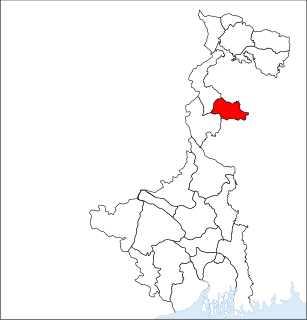Dr. Dhirendranath Banerjee was an Indian politician and physician. He was a founding member of the Revolutionary Socialist Party and an elected parliamentarian.

India is a country in South Asia. It is the seventh-largest country by area, the second-most populous country, and the most populous democracy in the world. Bounded by the Indian Ocean on the south, the Arabian Sea on the southwest, and the Bay of Bengal on the southeast, it shares land borders with Pakistan to the west; China, Nepal, and Bhutan to the north; and Bangladesh and Myanmar to the east. In the Indian Ocean, India is in the vicinity of Sri Lanka and the Maldives; its Andaman and Nicobar Islands share a maritime border with Thailand and Indonesia.

Revolutionary Socialist Party (RSP) is a political party in India. The party was founded on 19 March 1940 and has its roots in the Bengali liberation movement Anushilan Samiti and the Hindustan Socialist Republican Army. The party got around 0.4% of the votes and three seats in the Lok Sabha elections in 1999 and 2004. It is part of the Left Front (Tripura).
Banerjee became involved in political struggles during the 1921 Non-Cooperation Movement. [1] He studied at Rajshahi College, where he befriended members of the Anushilan Samiti. [1] He became an active member of the Anushilan Samiti resistance movement in the struggle for Indian independence. [1]

Rajshahi College is the third oldest institution of higher education in Bangladesh. Established in 1873 in Rajshahi city, it is the third oldest college in Bangladesh after Dhaka College and Chittagong College. In 1895, Rajshahi College was the first institution in the territories now comprising Bangladesh to award a graduate (master's) degree. The first two master's degree candidates, Mr. Cayan Uddin Ahmet(Chawyone Uddin Ahmed) and Mr. N. N. Lehari, after graduation became Chief Secretary of Bengal and Session Judge respectively. Later both were awarded Khan Bahadur and Roy Bahadur titles. Rajshahi College offers three years bachelor and four years honours degree courses in various disciplines. The college is affiliated with the National University. Since 1996 it has stopped enrolling higher secondary students. It again started enrolling higher secondary students in 2010. Situated in the city center, Rajshahi College is adjacent to Rajshahi Collegiate School and is very near the famous Barendra Museum.

Anushilan Samiti was a Bengali Indian organisation that existed in the first quarter of the twentieth century, and propounded revolutionary violence as the means for ending British rule in India. The organisation arose from a conglomeration of local youth groups and gyms (Akhara) in Bengal in 1902. It had two prominent, if somewhat independent, arms in East and West Bengal identified as Dhaka Anushilan Samiti centred in Dhaka, and the Jugantar group respectively.
Banerjee graduated from Campbell Medical School in 1928. [1] With a medical diploma, he opened medical practice in the country-side. [1] Whilst working as a physician he remained in touch with Anushilan Samiti. [1] Banerjee was arrested and jailed in 1934. [1]
Banerjee was a founding member of RSP in 1940. [1] He moved to Balurghat and worked on organising RSP in the northern parts of the province. [1] He led the 1956 anti-merger movement in West Dinajpur district (against merger of West Bengal and Bihar). [2] He won the unreserved seat in the Balurghat constituency in the 1957 West Bengal Legislative Assembly election. [3] He was a leading figure in the 1959 Food Movement in West Dinajpur district. [2]

Balurghat (pron:ˌbʌlʊəˈgɑ:t) is a city and a municipality in the state of West Bengal, India. It is the headquarters of the Dakshin Dinajpur district. Balurghat has for long been known for its distinguished taste in culture, especially theatre. It is the birthplace of Natyacharya Manmatha Ray. The town is well known for its cleanliness and culture.
West Dinajpur district was a district of the state of West Bengal from 1947 to 1992. At India's independence, the former Dinajpur district of undivided Bengal was partitioned along religious lines, and West Dinajpur became one of the 14 districts of West Bengal. The other part of the district continues as Dinajpur District, Bangladesh.

West Bengal is an Indian state located in the eastern region of the country along the Bay of Bengal. With over 91 million inhabitants, it is India's fourth-most populous state. West Bengal is the fourteenth-largest Indian state, with an area of 88,752 km2 (34,267 sq mi). A part of the ethno-linguistic Bengal region of the Indian subcontinent, it borders Bangladesh in the east, and Nepal and Bhutan in the north. It also borders the Indian states of Odisha, Jharkhand, Bihar, Sikkim, and Assam. The state capital is Kolkata (Calcutta), the seventh-largest city in India, and center of the third-largest metropolitan area in the country. As for geography, West Bengal includes the Darjeeling Himalayan hill region, the Ganges delta, the Rarh region, and the coastal Sundarbans. The main ethnic group are the Bengalis, with Bengali Hindus forming the demographic majority.
Banerjee died in Balurghat on January 8, 1978, at the age of 74 years. [1]

